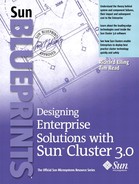Shared Storage Design
Shared storage devices are devices connected to more than one host. Using the Sun Cluster 3.0 software, you can make these devices highly available. Shared storage devices differ from local storage devices that are directly connected to only one host. You can make local and shared storage devices globally available by using the Sun Cluster software; however, only shared storage can be made highly available to the cluster and be accessible when a node has failed. You can use any storage devices the node platform supports for local storage. Shared storage devices have additional restrictions. Some features of storage devices that contribute to increased availability are these:
Dual redundant, N + 1, or 2N + 2 power supplies.
Internal battery backup or integrated UPS.
Multiple power sources.
Redundant or N + 1 cooling.
Hot-pluggable FRUs.
Hardware RAID controller with data-protected, nonvolatile cache.
Multiple host support. This requires SCSI-2 reservation support or the equivalent for devices that support two hosts. Devices that support more than two hosts require SCSI-3 persistent group reservation (PGR).
Spare disk drives that can be enabled when an active drive fails.
Before you complete your system design, verify support of shared storage, host bus adapter (HBA), and server configurations. Also, use reliability block diagram (RBD) analysis (see “Reliability Block Diagram Analysis”) to verify that the storage subsystem design provides reliable access to at least half of the storage devices.
